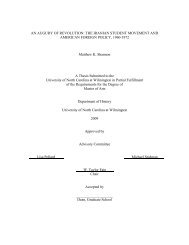Saprolegnia - The iLumina Digital Library
Saprolegnia - The iLumina Digital Library
Saprolegnia - The iLumina Digital Library
Create successful ePaper yourself
Turn your PDF publications into a flip-book with our unique Google optimized e-Paper software.
irregular; unbranched, branched, or forming a glomerulus. Oospores centric or<br />
subcentric; spherical or compressed at one side, or ellipsoidal; 1-2 (-4) per oogonium,<br />
and generally not filling it; (l6-) 32-38 (-43) µm in diameter; germination not observed.<br />
Antheridial apparatus absent.<br />
<strong>Saprolegnia</strong> unispora is recognized chiefly by its short-stalked, large, generally<br />
spherical oogonia (often in glomeruli or on once-branched stalks) usually containing a<br />
single, large, centric or subcentric oospore, but having no attendant antheridial<br />
filaments. Thus, in all essential features but one -- the lack of an antheridial apparatus --<br />
S. unispora is hardly distinguishable from S. megasperma (compare Figs. 93 H, 100 K).<br />
Nolan (1975a), in fact, theorized that S. unispora might represent part of an evolutionary<br />
trend from S. megasperma through a form of the latter possessing what were alleged to<br />
be parasitic antheridial branches.<br />
Although <strong>Saprolegnia</strong> unispora shares with S. itoana the characteristic of a single<br />
oospore (predominantly) in each oogonium (Fig. 100 C-H), these species are unlike in<br />
two other features of taxonomic value. <strong>The</strong> oogonial stalks of S. itoana (formerly<br />
recognized as S. subterranea by Seymour, 1970) are consistently longer than those of S.<br />
unispora. Moreover, S. itoana usually forms antheridia whereas S. unispora is not known<br />
to do so.<br />
Coker and Couch (Coker, loc. cit., pl. 23, fig. 12) describe the oospores of Isoachlya<br />
(=<strong>Saprolegnia</strong>) unispora as centric, but the illustration of the “...ripe...” eggs depicts them<br />
unmistakably as subcentric. This error is repeated in Coker and Matthews (1937). In all<br />
probability the S. unisperma referred to by Dick (1973:138) was S. unispora.<br />
CONFIRMED RECORDS: -- AUSTRALIA: Cookson (1937:241). BRITISH ISLES:<br />
R. A. Couch (1951:107, p1s. 19-21). CANADA: Maestres (1977:149, fig. 64).<br />
CZECHOSLOVAKIA: Cejp (1959a:199, fig. 70g-l). INDIA: Dayal (1958:50, pl. 2). JAPAN:<br />
Okane (1977:6, figs. W, X). REPUBLIC OF CHINA: Volz et al. (1974:231, fig. 8). UNITED<br />
STATES: R. L. Butler (1975: figs. 49-52); Coker and Couch (loc. cit.); Seymour (loc. cit.); A.<br />
W. Ziegler (1948b:19, pl. 2, figs. 7-11; pl. 3, fig. 1; 1952: 8, pl. 2, fig. 10). USSR:<br />
Morochkovs’kii et al. (1967: 134, fig. 120).<br />
RECORDED COLLECTIONS: -- BRITISH ISLES: Apinis (1964); Cook and<br />
Morgan (1934). CANADA: Dick (1971c); Maestres and Nolan (1978). GERMANY:<br />
Höhnk (1935a; 1956a). INDIA: Dayal (1959). JAPAN: Okane (1978); Suzuki (1961f, i).<br />
NEW ZEALAND: Karling (1966f). REPUBLIC OF CHINA: Liu and Volz (1977). SOUTH<br />
AMERICA: Upadhyay (1967). UNITED STATES: G. C. Hughes (1959, 1962); T. W.<br />
Johnson (1956a); T. W. Johnson and Surratt (1955); V. D. Matthews (1935); Scott (1960b);<br />
Slifkin (1964); A. W. Ziegler (1958b). USSR: Dudka (1965, 1966); Logvinenko and<br />
Meshcheryakova (1971).<br />
SPECIMENS EXAMINED: -- UNITED STATES (11), TWJ, RLS. Centraalbureau<br />
(2).<br />
<strong>Saprolegnia</strong> megasperma Coker<br />
638
















